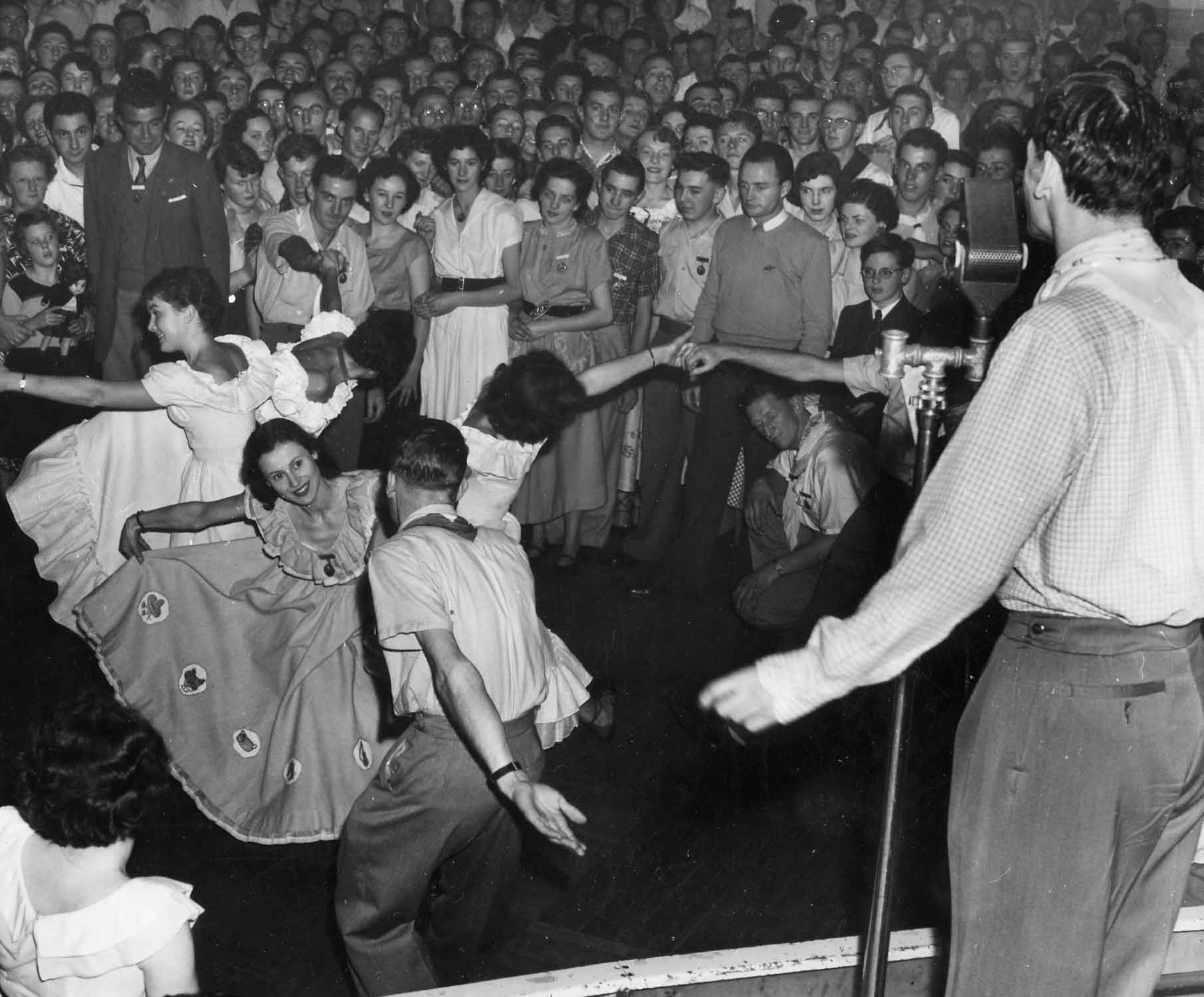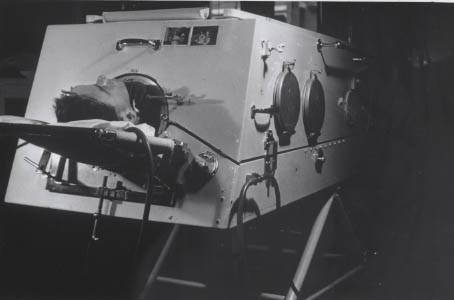


| |
|
Square Dancing - How It All Started in Australia by Jack Murphy Jack Murphy is a long surviving Melbourne Caller since the 1950's who developed his skills through the McGrath square dance camp. Jack had great longevity - surviving more than 50 years in square dancing. Two of Jack's many square dance recordings are included in the 'Square Dance Heritage' section of this site for your listening pleasure. Jack (aged 87) and Jim (aged 88) had morning tea together in 2006 at Jack's retirement village when the photo at right was taken. At this reunion they of course shared stories about the 1950's square dance boom. Jack had recorded his recollections which is published below (we've created some links - underlined - to audio files so you can listen to the work of a few callers mentioned by Jack):
Several small groups had been square dancing before these events took place, mainly with a small repertoire of singing calls. In New South Wales Eddie Carol had been trying to popularise square dancing ever since he learnt to call as a young lad, with little success and much opposition from dance promoters. An American caller named Leonard Hurst here with the American services during the war, led American servicemen and local girls through their paces at the Red Cross Recreational Centre in Townsville, Queensland, while he was stationed there. He later married an Australian and made Adelaide his home. These were only isolated events. The growth of square dancing in Australia really dates from the first two events mentioned. The first event took place at the Teachers' College summer camp at Queenscliff, Victoria, in 1949. The two girls back from Japan were attending the camp and they passed on the knowledge of square dancing that they had learnt there. Also at the camp was Bill McGrath, a lecturer in physical education. Square dancing interested him right from the start and he began learning all he could about it. From then on it became a regular activity at the Melbourne Teachers' College, and Bill McGrath set out to interest other people. In March 1950, the Teachers' College held a square dance in Melba Hall, at Melbourne University, attended by over 400. Many other demonstrations were given throughout Victoria in 1950 by Bill McGrath's exhibition sets, and over 6,000 people went to the Melbourne Town Hall to see a "Hollywood Square Dance Contest". Square dancing in Victoria became very competitive and the Victorian Championships were held that year in Prahran Town Hall. Twenty-two sets were entered and all three places were taken by sets trained by Bill McGrath. On the whole, 1950 was a year of struggling to interest people in Victoria without much success. But at the end of the year an event took place in 1950 which was to lead to the forming of Melbourne's first square dance club. During the Christmas holidays a group of people with homes on the Ranelagh Estate bought a set of Joe Lewis' records and got together to work out the cells and dance to them. Joe Lewis' first visit to Australia also took place in 1950, when he gave exhibition to big crowds in Sydney. This led to a boom in square dancing in Sydney for a while, but it soon died, due to a lack of suitable callers and the fact that some of them made a farce of the dancing and dressing, It was the second visit of Joe Lewis in 1951 to conduct the "Women's Weekly" 6,000 pounds competition that gave square dancing its big and much needed boost. In conjunction with the Australian Championship, Joe Lewis called for many exhibitions at leading stores in both Melbourne and Sydney, and brought square dancing to the notice of a big section of the public (click here to view a 2 minute heritage film of Joe's arrival at Melbourne Airport) Eddie Carol was the official caller for the Australian Championship which was won by the "Denver Dudes" of Sydney. Members of the set were: Gary Cohen, Roy Starkey, Colin Lister, Sydney Tomlin, Pat Cohen, Marie Weston, Shirley Clifford and Ivy Newman. A Victorian set was second. Joe Lewis was the judge. Local callers, Eddie Carol and Bill McGrath in particular, were also able to gain much valuable experience from Joe Lewis. Joe left behind a band of well trained dancers, many of whom later became callers. Now let's get back to the group of people at Ranelagh Estate who taught themselves to dance from records. When the big competition was announced they decided to enter a set in the Victorian section. They had caller Charles Leesing to train them, and danced so well that they reached the final round. After the competition they decided to form themselves into a club, and so Melbourne's first club, the Village Square Dance Club, at Toorak came into being. Charles Leesing continued to call for them for a while, then Bill McGrath took over, and by the end of 1951 the club had closed its membership. In Sydney after the competition, Eddie Carol was selected to call at the Trocadero, one of Sydney's biggest ballrooms, and many clubs sprang up. The stage was then set for the square dancing boom to begin. The Village Club had closed its membership and was rapidly reaching an advanced standard of dancing. To cater for the overflow of dancers another club was opened at Brighton early in 1952. The craze was spreading, and by the middle of 1952 new clubs were forming almost every week. Two such clubs, Valetta and Whitehorse are still operating today with their original callers, Wally Cook and Jack Murphy. Some clubs were banded together under the Square Dancing Society of Victoria, and Bill McGrath had begun training a team of callers to take over the new clubs as they opened. By this time the big ballrooms were beginning to sit up and take notice. They soon realised that square dancing had taken a good hold and that ballroom dancing must suffer as a result. In September 1952 Earl's Court, St. Kilda, opened for square dancing, and Leggett's, Prahran, followed suit. A young Melbourne journalist, Jim Vickers-Willis, who had been dancing with the Brighton club, began calling at both ballrooms. As an experiment a broadcast was made from the Earl's Court dance, and it proved an immediate success. This broadcast and the many others that followed did much to bring square dancing to everybody's notice, and the boom was then really under way. By the end of 1952 the Square Dancing Society had over 100 clubs and more callers were being trained. In Sydney square dancing had once again left the big halls, but was still going strong in a number of small clubs. It was about this period that some present day callers namely Wally Cook (Vic), Jack Murphy (Vic), Ron Jones (NSW), Les Johnson (W.A.), Kevin Leydon (Vic) and Lee McFadyean (Vic) commenced their calling careers followed by Graeme Rigby (Qld) and Graeme Whiteley (Tas) in 1953 and Allan Frost (S.A) in 1954. Eddie Carol with his wide experience and knowledge soon became a firm favorite with Melbourne square dancers. He brought with him many new ideas and dances, which he passed on to Melbourne callers, and Leggett's soon had to increase its square dances to five nights a week. Early in 1953 Cr. and Mrs. McIntyre, Mayor and Mayoress of Box Hill decided to give a Mayoral Square Dance Ball - Australia's first with Jack Murphy as the caller. All the guests were square dances and they bowed to the Mayoral couple in true square dance style. The Whitehorse presentation set after making their bows gave an exhibition. New South Wales: In the early fifties square dancing staged a revival in Sydney with the formation of the Australian National Square Dance Club, which had opened beginners' nights in several suburban ballrooms and town halls. Two of the early established Sydney clubs were the Carrs Park and Balgowlah clubs. The Carrs Park club was restricted to married couples only. Prominent callers in Sydney at the time were: Ron Jones, Gary (Chuck) Cohen, Smiling Billy Blinkhorn, Alan Blackwell, Jack De-La-Warr and Erin O'Daly. South Australia: Adelaide's first club
was launched by American caller Leonard Hurst in 1951 at the T.W.C.A.
known as the "Sundowners" which became a training ground for
future callers. Len Peters was to become the first local caller. For
a while Jim Vickers-Willis flew weekly from Melbourne to call at the
Palais Royal and Graham Stone also called there as well as at the Embassy. Western Australia: Square dancing in Perth started in 1953 and was restricted to a few small groups, meeting at irregular intervals. The first clubs to form were Milsurf in Subiaco with caller Ross Ewen who was a lecturer in Physical Education at the Teachers College and Circle "C" with caller Laurie Nash, also a club named Orano. Square Dancing was given a boost in 1954 when a dancer named Fred Humphries who was a starter at the 1956 Olympic Games, invited Bill McGrath and Jack Murphy and his Whitehorse Exhibition set to perform in Perth at such clubs as Milsurf, Circle "C", Mt Lawley & Bunbury. Queensland: Square dancing also came to Brisbane in 1953 but was confined to, small groups, until the arrival of Melbourne callers Bernie Kennedy and Doug Neeson. Clubs then opened very quickly with local callers John Gurney, Harvey Lake, Ray Ryan and Graham Rigby. Tasmania: In Hobart, square dancing commenced in 1953 at Charlie Brown's with headquarters in the Royale Ballroom with caller Freddy Goninon. Brown and Goninon virtually pioneered square dancing in Hobart. Apart from Goninon there was a caller named Peter Smith who conducted his own club. Peter had been calling for sometime as he started back in his homeland - England. In 1953 Launceston boasted as many as 22 clubs. The Northern clubs formed an association and in conjunction with Radio 7EX and the National Fitness Council conducted Tasmania's first Square Dance Festival at Campbell Town. Graeme Whiteley also started his calling career about this time.
For further information on Australia's rich square dance heritage, we recommend you visit our section titled Australian 1950's Square Dance Archive.
|
'Not the Retiring
Types'
|
Return to AUSTRALIAN SQUARE DANCE ....with Jim Vickers-Willis
All materials on this site are Copyright©Vickers-Willis Corporation, 2017